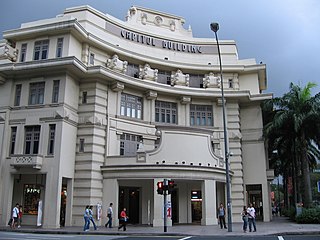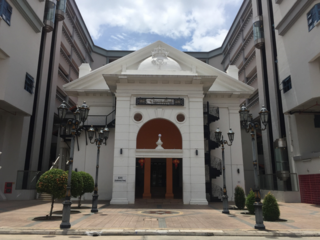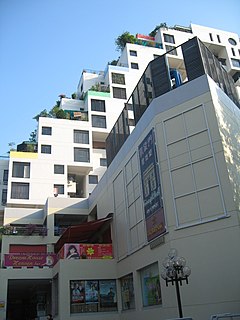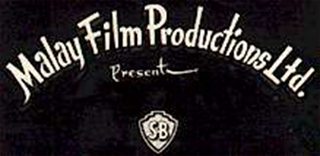Related Research Articles

Shaw Organisation is a film distribution company and cinema chain founded by brothers Runme Shaw and Run Run Shaw who went to Singapore in the 1920s to expand their family business founded by Runje Shaw. The company originally operated as a distributor for the Shaw brothers' Tianyi Film Company in Shanghai. Run Run Shaw later moved to Hong Kong in the 1950s to run Shaw Brothers Studio, whilst Runme Shaw stayed in Singapore to continue Shaw Organisation's operations. Unlike Tianyi, Shaw Organisation does not produce films but distribute them in their theatres.

Runme Shaw, K.St.J was the chairman and founder of the Shaw Organisation of Singapore. Runme Shaw and his brother, Run Run Shaw, together known as the Shaw Brothers, were pioneers in the film and entertainment industry in Singapore and Malaya, and brought to life the movie industry in Asia, especially the Southeast Asian region.

Balestier is a sub zone located in the planning area of Novena in the Central Region of Singapore. The main road, Balestier Road, links Thomson Road to Serangoon Road and the road continues on as Lavender Street. The area is home to rows of shophouses, such as the Sim Kwong Ho shophouses, the Balestier Art Deco shophouses, 412-418 Balestier Road, and 601-639 Balestier Road, low-rise apartments and commercial buildings as well as a shopping mall known as Shaw Plaza. However, Shaw Plaza has since closed down and is under construction. Balestier also has another mall, Zhongshan Mall. There are several lighting and electrical shops along Balestier Road, which is also home to the Ceylon Sports Club and the Indian Association. The area is known for its food such as bak kut teh and chicken rice. In the area, there are several apartments, condominiums, and budget hotels.

Capitol Building, formerly Shaws Building and Namazie Mansions, is a historic building at the junction of North Bridge Road and Stamford Road in the Downtown Core of Singapore. The building had since redeveloped along with adjoined Stamford House and both were reopened as a hotel The Capitol Kempinski Hotel Singapore in October 2018.

Ken Kwek is a Singaporean screenwriter, director, playwright and author. His short film compendium, Sex.Violence.FamilyValues, was banned by the Singapore and Malaysian governments in 2012. His first feature film Unlucky Plaza premiered at the Toronto International Film Festival in 2014. His second feature #LookAtMe premiered at the New York Asian Film Festival in 2022, to critical acclaim. He has written several full-length plays, including the #MeToo drama, This Is What Happens To Pretty Girls, which premiered in Singapore in 2019. He is also the author of several best-selling children’s books including Kelly and the Krumps, which won the Hedwig Anuar Book Award in 2020.
Rex Cinemas Mackenzie, formerly Rex Cinemas and Rex Theatre, is an Art Deco style cinema building in Singapore. the cinema was adjacent to Ellison building along Mackenzie Road. The cinema was bounded by major road, Bukit Timah Road and secondary roads Mackenzie and Selegie Road.

The Former Queen's Theatre is located at the Geylang Road, opposite Lorong 41 road. The theatre had been one of the main entertainment places in Geylang from 1930 to 1982. The building was named Wembley Cinema from 1930 to 1933, Ritz Cinema from 1933 to 1939, and Queen's Theatre from 1939 until it was closed in 1982. The front facade of the building is now conserved and becomes part of the GrandLink Square.

Capitol Theatre, briefly Kyo-Ei Gekijo, is a historic cinema and theatre located in Singapore. It was adjoined to four-storey building known as the Capitol Building. The Capitol Theatre was considered one of Singapore's finest theatres in the 1930s during that time.

Shaw Tower, also sometimes referred to as Shaw Towers, is a defunct high-rise commercial building located on Beach Road in Singapore. At the time of its completion in 1975, the tower housed the largest cinema in Singapore.

Whampoa Makan Place is a hawker centre and wet market on blocks 90, 91 and 92 along Whampoa Drive in Whampoa, Singapore. The centre is divided into two sections, with one being the hawker centre, and the other being the wet market.

Balestier Point is a high-rise mixed-use development in Balestier, Singapore with retail outlets on the lower floors, and residential units in the upper floors.
Sun City Live Theatre was the only English-language live theatre in Singapore, located in the Orchard Towers.
Shaw Plaza, also known as Shaw Plaza-Twin Heights is a mixed-use development in Balestier, Singapore. The plaza is currently under major renovations.
Ruby Theatre, also known as the Ruby Cinema, was a theatre located along Balestier Road in Balestier, Singapore.

The Malay Film Productions Ltd., also known as the Shaw Studio, is a former film studio located on Jalan Ampas in Balestier, Singapore. The studio operated from 1947 to 1969 with more than 150 movies produced, and was a major contributor to the Golden Age of Malay Cinema. Many of the films are critically acclaimed, a significant number of which involved P. Ramlee as actor, director, writer or composer.
The Sim Kwong Ho shophouses are a row of shophouses located on the corner of Balestier Road and Kim Keat Road.
Lam Yeo Coffee Powder Factory, also known as simply Lam Yeo Coffee Powder, is a shop selling roasted coffee beans and coffee powder blends along Balestier Road in Balestier, Singapore.
The Balestier Art Deco shophouses are two shophouses located on 230 & 246 Balestier Road in Balestier, Singapore.
Tai Pei Yuen is a Buddhist temple located along Jalan Kemaman in Balestier, Singapore.
References
- 1 2 3 4 Nureza, Ahmad. "Hoover Theatre". Singapore Infopedia. National Library Board . Retrieved 3 April 2022.
- ↑ "Japanese films". The Straits Times . Singapore. 10 September 1977. Retrieved 3 April 2022.
- ↑ "Live Shows". The Straits Times . Singapore. 26 January 1983. Retrieved 3 April 2022.
- ↑ "Hoover gets the green light". Singapore Monitor. Singapore. 9 February 1983. Retrieved 4 April 2022.
- ↑ Wong, Sing Yeong (19 January 1985). "Will the 'live' theatres die?". Singapore Monitor. Singapore. Retrieved 4 April 2022.
- ↑ Sit, Yin Fong (3 July 1985). "The show goes on at Hoover despite winding-up petition". Singapore Monitor. Singapore. Retrieved 4 April 2022.
- ↑ "Hoover Theatre joins list of cinemas turned into churches". The Straits Times . Singapore. 11 February 1989. Retrieved 4 April 2022.